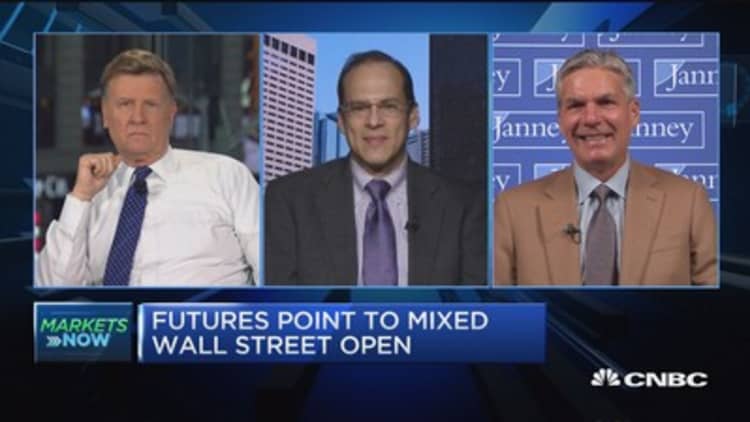Investors are in for a rude awakening about a coming stock market correction — most just don't know it yet. No one knows when the crash will come or what will cause it — and no one can. But what's worse for most investors is they have no clue how much they stand to lose when it inevitably happens.
"If you look at the market historically, we have had, on average, a crash about every eight to 10 years, and essentially the average loss is about 42 percent," said Kendrick Wakeman, CEO of financial technology and investment analytics firm FinMason.
Many investors have no idea how their portfolios would fare if the equity market took a big hit, according to a risk-tolerance survey FinMason did late last year. Most investors are unaware of the amount of risk in their equity portfolios. As a result, these investors make poor, costly sell decisions at the worst time: when the markets do correct.
"That's a big problem," Wakeman said. Most individual reactions to an unexpected loss are much worse than reactions to an anticipated one.
Only 57 percent of investors (both those who have an advisor and those who don't) said they understand the term risk tolerance. Investors who work with an advisor do know more: 68 percent understand their individual risk tolerance. But working with a financial advisor hasn't helped as much as it should. Only a little more than one-quarter of those who work with an advisor (27 percent) had been told by the advisor how much their portfolios could lose if there were a market crash.
Of those investors whose advisors had talked to them about a crash, 62 percent believe their loss would be less than what their stated exposure to equities would suggest, the survey found. The survey found that up to 57 percent of clients working with advisors will likely panic and sell in a crash.
You need to ask your clients, 'Would you hang yourself in the closet if the market crashed and you lost 35 percent?'Kendrick WakemanFinMason CEO
The worst-case scenario should be obvious. Long-term portfolio allocation science dictates only a small percentage of assets in cash, so as much as 90 percent to 95 percent of most portfolios are subject to huge short-term losses. Many investors felt this pain after the 2008 market crash, though those who remained invested at the 2008/2009 lows have more than made their money back in the years since — the S&P 500 Index is up 171 percent since the beginning of 2009.

"One of the problems we encountered in 2008 is that many people who were close to retirement also had lots of equity risk but didn't know about it," Wakeman said. "So when the market sold off, people panicked and sold and lost their path to retirement. "It's sad, because you had people who were working and who did all the right things and saved, and now they can't retire."
Brandon Corso, director at Edelman Financial Services, said advisors who downplay potential losses are making a mistake.
"The more surprised a client is, the more disappointed they usually are, and that is when they tend to react emotionally," he said. Corso prefers having a frank discussion with clients about the risk in their portfolio. "You do yourself a disservice if you gloss over it."
Having a blunt, but not terrifying, conversation
It's best for advisors to have this conversation in blunt language. How blunt? FinMason's Wakeman evokes horror stories from the Great Depression.
"You need to ask your clients, 'Would you hang yourself in the closet if the market crashed and you lost 35 percent?'" If the client says yes, then it's up to the advisor to help them design a portfolio that would lose less in that scenario, Wakeman said. He added, "It's the client taking the risk, so they are entitled to know the risk they are taking, and there is no better way to talk about it except in a crash scenario."
The less math-based the conversation, the better.
"If you say, 'Over the next six months, we think there is a 95 percent chance that you won't lose more than 17 percent,' that's a legitimate risk metric from a quantitative finance standpoint, but it's not a good way to explain risk to people with no financial training," Wakeman said.
More from Portfolio Perspective:
Relocating in retirement should be done with caution
5 mistakes to avoid when rebalancing a portfolio
Overlooked tax deductions that will cost you
John Ndege, CEO of the risk tolerance software provider Pocket Risk, said the time is ripe for advisors to be having this talk with clients. "The only time the markets have seen such a bull run as there has been since 2009 was right before the dot-com crash and before the Depression," Ndege said. "You need to ask them how secure their job is and do they have enough cash saved for a rainy day.
"You should also check in to see if a client will be able to stomach a collapse, and if there is some kind of recession or downturn, are they ready for it?"
Ndege focuses on two kinds of risk analysis. Risk tolerance involves having a thorough understanding of someone's psychological risk tolerance and how much of a drop in their portfolio they can handle psychologically before they want to sell. Risk capacity is more objective. It looks at how much the person has saved, the security of their income and whether they will need to withdraw assets any time soon.
The fine line is to have this conversation without scaring the clients.

"The capacity of the U.S. financial markets to adapt and re-price and recover is extraordinary," said Jim Dowd, CEO of North Capital, a registered investment advisor and investment management firm.
He doesn't talk to clients about a worst-case scenario, "because the worst case is the one we have not imagined yet," he said. Instead, Dowd explains to clients that while "there are certain aspects of market collapses or boom bust cycles that do echo each other and are similar, it never happens in the same way, and the catalyst is never the same."
Dowd said the biggest issue he runs into today is how badly the Great Recession wounded many investors. Clients aren't taking too much risk in their portfolios; they don't have enough risk to meet long-term goals. They have large cash positions and are afraid to dip their toes in the water. Inflation and loss of purchasing power make that a big investing problem to solve.
There will likely be periods of time when client accounts fall in value, but that should not be a reason to jump ship if advisors communicate effectively.
"The more we can get clients to ignore what might happen month to month in the market and instead focus on their long-term goals, the better," said Corso at Edelman.
It's also a good idea to remind clients about the risk-reward trade-off. "When throwing out a number like a 35 percent loss, you have to also show people that they are taking that risk because they are hoping that it will translate into a gain, which is income in retirement," said Wakeman of FinMason. "Without talking about the reward component, all that is left is risk aversion, and you end up scaring people at a time when investors need to be looking at building income," he said.
Wakeman said any advisor who enjoys "keeping clients confused because it gives them an overarching authority" is making a mistake. Clients are becoming more diligent about asking questions rather than blindly trusting their advisors.
"There is a new group of investors out there — millennials — so advisors need to move to a more collaborative conversation because millenials don't trust anybody," he said. "Millennials have the time to weather a few market declines. I tell them, 'By the time you retire, the market will crash three to four times, so get used to it.'"
— By Leslie Kramer, special to CNBC.com





